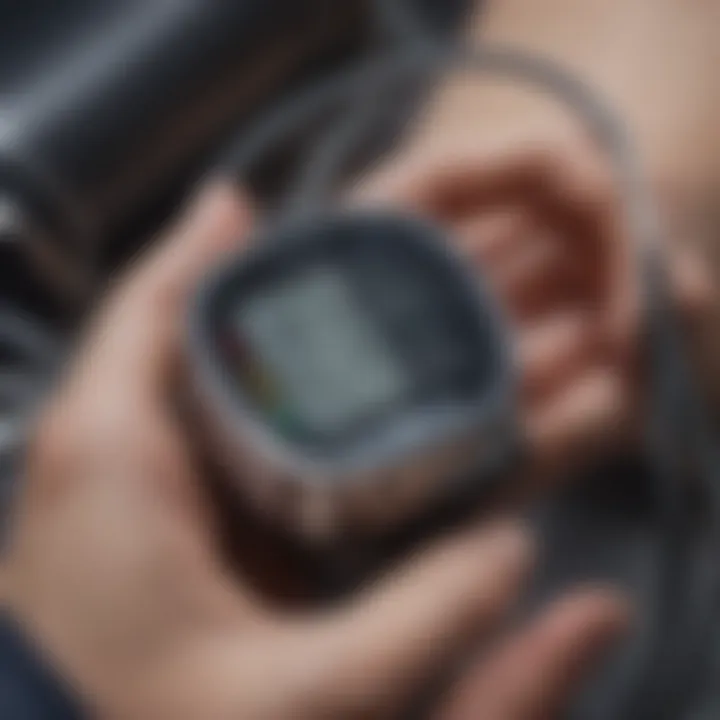Comprehensive Examination of Blood Pressure Measurement Techniques


Intro
Measuring blood pressure is fundamental in assessing an individual’s cardiovascular health. It serves as a primary indicator of various health conditions, making the techniques used in this measurement crucial for both diagnostic and management purposes. This article explores the various methods of blood pressure measurement, highlighting their significance in clinical practice. Through both traditional and modern technologies, we will examine how these techniques evolve and their implications on overall health.
Various factors affect blood pressure readings, necessitating precise measurement techniques. Understanding these can significantly impact patient management and treatment outcomes.
Throughout the article, we will address critical concepts surrounding blood pressure monitoring. This includes techniques such as auscultatory and oscillometric methods, as well as automated devices. Furthermore, we will discuss how accurate readings relate to cardiovascular disorders and patient management.
Research Overview
Key Findings
Blood pressure measurement is not merely about obtaining a number; it carries significant implications for overall health. Key findings from recent studies indicate that accurate measurement is associated with improved patient outcomes in hypertension management.
Establishing a standardized protocol for measuring blood pressure has improved the reliability of readings. Studies show that incorrect techniques contribute to misdiagnosis, highlighting the need for improved training for healthcare professionals.
Study Methodology
A review of literature was conducted, focusing on studies published in peer-reviewed journals over the last decade. These studies utilized various methodologies, from cohort studies to randomized controlled trials, allowing a comprehensive analysis of blood pressure measurement methods.
Background and Context
Historical Background
The practice of measuring blood pressure dates back to the 19th century with Sir Thomas Young and later, the sphygmomanometer introduced by Samuel Siegfried Karl von Basch. These advancements paved the way for modern techniques. Since then, methods have evolved significantly, leading to more accurate and accessible tools for blood pressure assessment.
Current Trends in the Field
Currently, there is a notable trend towards using automated devices for blood pressure measurement. Devices such as the Omron BP786 and the Withings BPM Connect are increasingly used in both clinical and home settings. These devices often provide real-time monitoring, allowing for better patient engagement and management of hypertension.
In addition, there is growing evidence on the importance of continuous monitoring and telehealth. These advancements offer new avenues for managing blood pressure effectively and efficiently.
"Accurate blood pressure measurement provides vital insights into cardiovascular risk and aids in effective patient management."
Preamble to Blood Pressure Measurement
Blood pressure measurement is a fundamental aspect of clinical practice. It serves as an essential tool for diagnosing and monitoring a variety of health conditions. Hypertension, often termed the ‘silent killer,’ can lead to serious cardiovascular events if not detected early. Thus, understanding various techniques to measure blood pressure is crucial for healthcare providers. This article intends to provide a comprehensive examination of blood pressure measurement techniques and their implications, highlighting both traditional methods and emerging technologies.
Definition and Importance
Blood pressure, fundamentally, is the force exerted by circulating blood on the walls of blood vessels. It is typically expressed in millimeters of mercury (mmHg) and presented by two numbers: systolic (the pressure during heartbeats) and diastolic (the pressure between heartbeats). Monitoring these values is important as they provide insights into an individual’s cardiovascular health. Elevated blood pressure readings can indicate potential complications such as heart disease, stroke, and kidney failure.
The importance of accurate blood pressure measurement cannot be overstated. It enables healthcare professionals to identify patients at risk and implement timely interventions. In essence, this practice not only aids in diagnosing conditions but also facilitates the ongoing management of treatments, ensuring patient safety and well-being.
Historical Perspective
The history of blood pressure measurement dates back centuries. The earliest methods for gauging blood pressure can be traced to ancient civilizations using rudimentary techniques, yet it wasn’t until the late 19th century that significant advancements emerged.
In 1881, Samuel Siegfried Karl Ritter von Basch developed the first sphygmomanometer, a method that relied on inflated cuffs to assess pressure. Later, in 1905, the Russian physician Nikolai Korotkoff introduced an innovative auscultatory approach, allowing for more precise readings by listening to the sounds of blood flow.
Moreover, advances continued through the 20th century with the advent of automated devices, greatly improving the ease and accuracy of blood pressure measurement. Today, medical professionals utilize a range of techniques, from traditional manual methods to sophisticated wearable technology, ensuring comprehensive monitoring in diverse settings.
Anatomy of Blood Pressure
Understanding the anatomy of blood pressure is essential as it provides a foundational grasp on how blood pressure works in relation to human physiology. This knowledge informs the correct approaches to measurement and management, facilitating better cardiovascular care. The significance of blood pressure anatomy can be seen through its impact on various health conditions, as blood pressure readings are fundamental indicators of systemic health. Accurate understanding helps healthcare providers design effective treatment strategies.
Physiological Mechanisms
The physiological mechanisms behind blood pressure regulation involve a complex interaction between the heart, blood vessels, kidneys, and nervous system. The heart acts as a pump, pushing blood into the arteries at a specific pressure. Blood vessels, particularly the arterioles, respond to various stimuli, influencing their diameter and thus affecting blood pressure. For instance, when blood vessels constrict, blood pressure rises; conversely, dilation results in lower pressure. Additionally, the kidneys help maintain blood pressure by regulating fluid balance and producing hormones like renin, which plays a role in blood volume and vessel tone.
These mechanisms highlight the importance of maintaining homeostasis. Disruptions can lead to health issues such as hypertension or hypotension. Therefore, understanding how these components interact is crucial for any examination of blood pressure measurement techniques.
Factors Affecting Blood Pressure
Several factors can influence blood pressure readings, and understanding these factors is pivotal for accurate assessment.
Age
Age is a significant factor affecting blood pressure. As individuals age, their arterial walls tend to stiffen due to changes in the connective tissues. This leads to a rise in systolic blood pressure, a common occurrence in older adults. The key characteristic of age-related changes is the increased vascular resistance. This makes age a valuable aspect to consider in any comprehensive discussion about blood pressure measurement. However, the disadvantage lies in the fact that age-related changes can obscure the recognition of pathological conditions in younger populations, thus complicating diagnosis and management.
Gender
Gender also plays a crucial role in determining blood pressure levels. Studies indicate that men tend to have higher blood pressure than women before menopause, likely due to hormonal differences. The unique feature of gender in blood pressure studies is the varying response to stressors and lifestyle factors. For instance, women often show a more resilient blood pressure response during pregnancy. Understanding these differences is essential for tailoring blood pressure management strategies, though it can sometimes limit the generalizability of findings across diverse populations.
Ethnicity
Ethnicity influences blood pressure through genetic predispositions and lifestyle factors. Certain ethnic groups, such as African Americans, have a higher prevalence of hypertension than others. The key characteristic here is the disproportionate impact of socio-economic factors that influence access to healthcare and healthy lifestyle choices. Recognizing ethnicity-related patterns can guide targeted interventions but may also introduce biases in how individuals are treated based on assumptions about their risk levels.
Body Mass Index
Body Mass Index (BMI) is a crucial factor in assessing cardiovascular health and its associated risks. High BMI is commonly correlated with increased blood pressure due to higher adipose tissue, which can secrete hormones that elevate blood pressure. BMI is beneficial for identifying at-risk populations. However, its limitations lie in using BMI as a sole determinant since it does not account for muscle mass or body composition.


Understanding these factors is crucial for accurate blood pressure measurement and interpretation. By considering the impact of age, gender, ethnicity, and BMI, practitioners can develop a more nuanced approach to monitoring and managing blood pressure.
Traditional Measurement Techniques
Traditional measurement techniques have long served as the cornerstone of blood pressure assessment. Their value lies in their established reliability and simplicity, which are pivotal in delivering accurate readings. Various methods exist, each with its own strengths and weaknesses, relevant for different contexts and clinical scenarios. Understanding these techniques is essential for healthcare professionals and patients alike. It ensures proper observation and response to variations in blood pressure, a critical factor in cardiovascular health.
Sphygmomanometry
Manual Method
The manual method of sphygmomanometry remains a classic and effective approach to measuring blood pressure. This technique entails using a sphygmomanometer equipped with a cuff and a stethoscope. The operator inflates the cuff and listens for Korotkoff sounds, which indicate systolic and diastolic pressure. The key characteristic of the manual method is its directness, allowing for immediate feedback on the blood pressure readings.
This method is popular among professionals due to its precision; trained personnel can recognize subtle variations in sounds that automated devices may miss. Its unique feature is the skill involved in auscultation, which can provide additional context regarding the patient's cardiovascular status. However, this technique also has disadvantages. It requires training to perform accurately, and the potential for user error exists, especially in high-stress environments.
Automated Method
In contrast, the automated method of sphygmomanometry employs electronic devices to measure blood pressure. These devices automatically inflate the cuff and display life blood pressure readings through sensors embedded in the system. The key characteristic of automated methods is their ease of use, making them accessible for both healthcare professionals and patients.
This method is beneficial for routine screenings and home monitoring because it reduces the need for specialized knowledge. A unique feature of automated sphygmomanometers is their ability to store multiple readings over time, allowing for better tracking of patient progress. However, these devices come with disadvantages, including susceptibility to calibration issues and reliance on batteries or power sources, which could lead to inaccuracies in certain settings.
Auscultatory Method
The auscultatory method is another critical traditional technique for measuring blood pressure. It involves using a sphygmomanometer and a stethoscope, similar to the manual method. However, this technique is specifically focused on detecting the Korotkoff sounds through careful auscultation. This method's primary advantage lies in its sensitivity to fluctuations in pressure, which provides a thorough understanding of the patient's condition.
Despite its many benefits, the auscultatory method may be affected by external noise or the skill of the individual performing the assessment. Training is essential to ensure accurate readings, especially in a noisy environment.
Palpation Method
The palpation method is perhaps the simplest of the traditional measurement techniques. It involves palpating a peripheral artery, typically the radial or carotid artery, while the cuff is inflated. This method is particularly useful in emergency situations where immediate and casual assessment is necessary. The primary advantage of the palpation method is its simplicity, as it does not require complex equipment.
However, it has notable limitations. This technique provides only the systolic reading and lacks the precision and reliability associated with more advanced methods. Furthermore, it is dependent on the healthcare provider's experience to correctly interpret the results.
In summary, traditional measurement techniques form an essential part of blood pressure assessment. Each method, from manual and automated sphygmomanometry to the auscultatory and palpation approaches, offers distinct advantages and considerations. Understanding these methods is crucial for accurate blood pressure monitoring and management.
Emerging Technologies in Blood Pressure Measurement
Emerging technologies in blood pressure measurement represent a significant evolution in the way healthcare professionals assess cardiovascular health. Traditional methods, while effective, often come with limitations related to patient experience, accuracy, and accessibility. Advanced technologies now provide a range of benefits that enhance the accuracy and ease of monitoring blood pressure. They also offer opportunities for patient engagement and improved health outcomes. The interplay between innovation and healthcare reflects the ongoing need for more efficient, user-friendly, and precise monitoring practices.
Wearable Devices
Wearable devices have become increasingly integral in the landscape of blood pressure monitoring. These gadgets, which can include smartwatches and fitness trackers, allow for continuous tracking of blood pressure readings. They offer convenience as users can measure their blood pressure throughout the day without needing to visit a clinic. This continuous monitoring can alert individuals and healthcare providers to irregularities and changes in blood pressure that may require attention.
Moreover, many modern wearable devices are equipped with algorithms that analyze data trends over time. This capability aids in identifying patterns that may not be evident through sporadic measurements. However, while these devices offer numerous advantages, it is essential to consider their accuracy. Validation studies are necessary to ensure that wearable devices maintain clinical relevance in providing reliable data to users.
Mobile Applications and Monitoring
The rise of mobile applications for blood pressure monitoring complements wearable devices effectively. These applications allow users to input their readings and track their blood pressure trends over time. They often provide educational resources and reminders for users to check their blood pressure regularly.
Some applications can connect to wearable devices and aggregate data, making it easier to monitor health metrics in one centralized location. This integration fosters a more comprehensive view of a person's health and facilitates communication between patients and healthcare providers. Users can share their data directly with their doctors, who can then provide tailored advice based on the information received.
That said, data security remains a significant concern. Users must ensure that the applications they choose have robust privacy policies in place. Protecting personal health information is paramount in the digital age.
Telemedicine and Remote Monitoring
Telemedicine is reshaping the delivery of healthcare services, particularly in the area of blood pressure monitoring. Remote monitoring allows healthcare providers to assess patients' blood pressure without requiring in-person visits, which can be particularly beneficial for those with mobility issues or those living in remote areas.
Through telemedicine platforms, patients can have consultations with their healthcare providers while sharing their blood pressure readings in real-time. This monitoring enhances patient engagement and helps ensure adherence to treatment plans. Additionally, it enables clinicians to make quicker decisions regarding medication adjustments or further testing as necessary.
However, for telemedicine and remote monitoring to be effective, both patients and providers must embrace technology. Training may be necessary to ensure that all parties understand how to utilize these platforms effectively. As the landscape continues to evolve, ongoing research should focus on optimizing these technologies for widespread use.
"As technology advances, the future of blood pressure monitoring resides in integrating traditional practices with innovative solutions that prioritize patient well-being and accessibility."
Interpretation of Blood Pressure Readings
Understanding blood pressure readings is crucial for both healthcare professionals and patients. It is not merely about obtaining a number; it encompasses interpreting the values correctly to guide treatment and lifestyle choices. Systolic and diastolic numbers are fundamental components of these readings. They are indicators of how well the heart is functioning and how much pressure blood exerts against the artery walls. This understanding can lead to better management of conditions such as hypertension and hypotension, impacting overall cardiovascular health.
Understanding Systolic and Diastolic Numbers
Blood pressure is measured in millimeters of mercury (mmHg) and consists of two values: systolic and diastolic pressures. The systolic number, which is the first value, represents the pressure in the arteries when the heart beats. It indicates how much pressure the blood is pushing against the vessel walls during contractions. Conversely, the diastolic number is the second value. It reflects the pressure in the arteries when the heart is at rest between beats. Both values provide critical insight into cardiovascular health.
Elevated systolic pressures often suggest conditions like heart disease or high blood volume. Meanwhile, elevated diastolic pressures may indicate arterial stiffness or resistance in the blood vessels. Thus, a complete understanding of these values is essential for healthcare providers when diagnosing and treating patients.
Classification of Blood Pressure Levels
Normal
Normal blood pressure is typically defined as having a systolic value less than 120 mmHg and a diastolic value less than 80 mmHg. Maintaining this range is essential for good health as it reduces the risk of cardiovascular diseases. The classification of "normal" blood pressure is popular among healthcare providers as it is associated with generally healthy lifestyles. However, individual variations do exist, and monitoring of blood pressure trends is necessary for a complete assessment of an individual’s health.
Elevated
Elevated blood pressure is characterized by systolic values ranging from 120 mmHg to 129 mmHg and diastolic values less than 80 mmHg. Duration in this range can progress to hypertension if unaddressed. This classification highlights the importance of lifestyle modifications to prevent further increases in pressure. The unique aspect of elevated readings is that they serve as a warning sign, urging patients to adopt healthier habits before the situation worsens.


Hypotension
Hypotension is defined by a systolic reading of less than 90 mmHg and a diastolic reading lower than 60 mmHg. While often perceived as less harmful than hypertension, low blood pressure can lead to dizziness and fainting, especially in susceptible individuals. The specific aspect of hypotension is that it can signal underlying health issues such as dehydration or heart problems. However, for some individuals, it may not pose any significant health risks, making it a complex area to navigate in clinical settings.
Hypertension
Hypertension occurs when systolic values are at or above 130 mmHg and/or diastolic values are at or above 80 mmHg. Chronic hypertension puts individuals at a higher risk for numerous health complications like heart attacks, strokes, and kidney failure. Its classification is vital for strategizing interventions. Hypertension requires careful monitoring and often a multidisciplinary approach to management, including lifestyle changes and medication. The unique characteristic here is the long-term health implications, necessitating continuous evaluation and treatment.
Accurate interpretation of blood pressure readings is essential to prevent misdiagnosis and ensure effective management of cardiovascular health.
Factors Influencing Blood Pressure Readings
Understanding the various factors influencing blood pressure readings is essential for accurate interpretation and management of cardiovascular health. Blood pressure measurements are not static; they fluctuate based on multiple variables. Recognizing these elements can enhance clinical decision-making and lead to better patient outcomes. This section focuses on the specific factors that can affect blood pressure readings, emphasizing their significance in both routine and clinical settings.
Timing of Measurement
The timing of blood pressure measurement plays a critical role in the accuracy of the readings. Blood pressure can vary throughout the day due to factors such as physical activity, stress, or even the consumption of food. Measurements taken in the morning may differ significantly from those taken in the evening.
To achieve more consistent and reliable measurements, it is advisable to establish a routine for when blood pressure is checked. Health professionals often recommend measuring blood pressure at the same time each day, ideally when the patient is at rest. This practice minimizes the impact of daily fluctuations and allows for better tracking of changes over time.
Body Position and Posture
The position of the body during blood pressure measurement can lead to significant differences in readings. The most common positions include sitting, standing, and lying down. Each position can produce variations in blood pressure due to changes in vascular resistance and blood flow. For instance, blood pressure is typically lower when lying down compared to standing.
When measuring blood pressure, patients should be seated comfortably with their back supported, feet flat on the floor, and arm at heart level. If possible, measurements should be taken after a few minutes of rest to ensure that the reading reflects a stable state. This reduces the risk of transient changes caused by body position.
Caffeine and Medication Influence
Caffeine consumption and the use of certain medications can also influence blood pressure readings. Caffeine is a stimulant that can cause a temporary increase in blood pressure. For individuals who consume caffeine regularly, the effects may vary based on their tolerance levels. Therefore, it is important to consider the patient’s caffeine intake before measuring blood pressure.
In terms of medications, some drugs, such as corticosteroids and certain anti-inflammatory medications, may elevate blood pressure, while others may have a lowering effect. Patients should provide a comprehensive list of their medications before any blood pressure assessment to ensure accurate interpretation. It is vital for healthcare providers to consider these influences when evaluating hypertension or other cardiovascular conditions.
"Awareness of the factors influencing blood pressure readings can significantly improve diagnostic accuracy, ultimately enhancing patient care and treatment outcomes."
Taking into account these factors can create a clearer picture when dealing with blood pressure data, enabling more informed clinical decisions. By understanding these influences, healthcare professionals can better guide patients in managing their blood pressure effectively.
Common Errors in Blood Pressure Measurement
Accurate blood pressure measurement is essential for effective clinical assessment and management. Common errors can lead to misdiagnosis and inappropriate treatment. Understanding these errors is pivotal for healthcare professionals. This section highlights the primary sources of inaccuracies in blood pressure reading to guide practitioners in ensuring reliable results.
User Error
User error constitutes a significant source of inaccuracy in blood pressure measurement. This can occur at any stage of the measurement process, often due to lack of proper training or understanding of techniques.
- Improper Technique: Many users, including healthcare professionals, might not follow standardized measuring protocols. For example, the patient's arm should be supported at heart level, yet it is often not raised correctly.
- Equipment Misuse: Users may fail to use the device properly. For sphygmomanometers, the cuff must be the right size for the patient’s arm. An ill-fitting cuff can lead to falsely high or low readings.
- Environmental Factors: External elements such as noise, stress, or temperature can affect results. The patient should be relaxed and seated quietly before measurement.
Improved training can reduce these errors. Regular calibration and user education about the importance of following procedures strictly are beneficial.
Device Calibration Issues
Device calibration issues also lead to erroneous blood pressure readings. Devices, whether manual or electronic, must be regularly checked and adjusted to maintain accuracy.
- Regular Maintenance: Automated devices in particular require routine calibration to ensure they remain precise. Failure to do this can result in dangerous misinterpretation of blood pressure levels.
- Quality of Devices: Not all devices are created equal. Some may degrade faster than others, affecting their performance. It's essential to utilize high-quality, clinically validated devices for consistent results.
- Outdated Technology: Older models may not meet current accuracy standards. Continuous advancements in technology mean older devices can provide misleading data.
Regular checks, maintenance, and using devices certified for clinical use are crucial steps in reducing calibration issues.
"Regular device calibration and user education are vital for accurate blood pressure measurement."
Clinical Applications of Blood Pressure Monitoring
Monitoring blood pressure is pivotal in modern healthcare. It serves not only as a diagnostic tool but also plays a significant role in ongoing patient management. Regularly measuring blood pressure helps in assessing and addressing various health conditions effectively.
For clinicians, having accurate and real-time information about a patient's blood pressure offers key insights into their cardiovascular health. This can guide treatment decisions, lifestyle changes, and further testing.
Furthermore, persistent monitoring allows for better identification of trends over time. This trend analysis is crucial in tailoring treatment plans that suit individual needs.
Patients with chronic conditions or risk factors greatly benefit from continuous blood pressure monitoring, which can alert healthcare providers to sudden changes that may require immediate intervention. In short, the clinical applications of blood pressure monitoring are far-reaching and integral to patient safety and effective care management.
Hypertension Management
Hypertension management relies heavily on accurate blood pressure readings. It serves as a cornerstone for treatment planning and efficacy assessment. Understanding a patient's blood pressure patterns can help healthcare providers determine the appropriate medication and dosages to control hypertension. Routine monitoring can also aid in identifying whether lifestyle interventions, such as diet and exercise, are making a difference.
By employing both office visits and home monitoring devices, health professionals can gather comprehensive data. This flexibility allows for a more personalized approach to patient care.
Efforts to address hypertension effectively also hinge on patient adherence to prescribed treatment, which can be better reinforced with consistent monitoring.
"Regular measurement of blood pressure can significantly mitigate risks associated with hypertension, improving long-term health outcomes."
Risk Assessment for Cardiovascular Diseases
Blood pressure monitoring is indispensable in cardiovascular risk assessment. Hypertension is a major risk factor for cardiovascular diseases, including heart attacks and strokes. Tracking blood pressure trends helps in identifying patients at high risk, enabling early interventions.


When evaluating a patient’s overall cardiovascular health, considering additional factors is important. Some of these include:
- Family history of heart disease
- Current medication
- Other health conditions like diabetes or high cholesterol
By integrating blood pressure data with other clinical insights, healthcare providers can formulate more comprehensive risk profiles. This process encourages proactive measures to mitigate risks before they escalate into more serious conditions.
By continuously improving the accuracy and frequency of blood pressure monitoring, healthcare professionals can better equip themselves and their patients to manage conditions that lead to cardiovascular diseases.
Ethical Considerations in Blood Pressure Measurement
Understanding the ethical considerations in blood pressure measurement is essential in clinical practice and research. This aspect of health care serves as a foundation for fostering trust between patients and medical professionals. Through ethical practices, healthcare providers ensure that individuals’ rights, privacy, and well-being are prioritized during the process of measuring blood pressure. Focusing on the ethical dimensions, two key components emerge: informed consent and data privacy and security.
Informed Consent
Informed consent is a fundamental ethical requirement that involves providing patients with sufficient information about procedures or treatments they undergo. For blood pressure measurement, it is not only about asking for permission but ensuring that patients understand the significance of the measurement. They should also be made aware of any potential risks or discomforts associated with the process.
- Benefits of Informed Consent:
- Enhances Trust: When patients feel they are well-informed, they are more likely to trust healthcare providers.
- Empowers Patients: Informed consent empowers individuals to take an active role in their healthcare decisions.
- Minimizes Legal Risks: Adhering to informed consent guidelines reduces the likelihood of legal issues related to perceived negligence.
In practice, obtaining informed consent for blood pressure measurement can involve explaining the purpose of the test, the method used, and how the results will inform patient care. Clear communication is crucial, as patients may have diverse backgrounds and levels of understanding regarding medical processes.
Data Privacy and Security
Data privacy and security represent critical ethical dimensions in blood pressure measurement, particularly in an age where electronic health records are prevalent. Ensuring the confidentiality of patient information is not only a legal requirement but also an ethical obligation.
- Key Aspects of Data Privacy and Security:
- Confidentiality: Personal health data should be accessible only to authorized personnel.
- Data Protection: Healthcare institutions must implement robust security measures to protect sensitive health information from breaches or unauthorized access.
- Transparency: Patients should be informed about how their data will be used, stored, and shared.
Protecting patient data enhances the trust between patients and healthcare providers, ensuring that individuals feel secure while engaging in necessary health assessments.
Through adhering to proper ethical practices, such as informed consent and strong data privacy standards, healthcare professionals can uphold the integrity of blood pressure measurement. In doing so, they support a healthcare environment that respects patient autonomy, builds trust, and promotes overall wellness.
Future Directions in Blood Pressure Technology
The field of blood pressure measurement is on the brink of several transformative changes. As technologies advance, there is a growing push towards more precise, user-friendly, and integrated systems. This section will explore how these innovations may reshape the future of blood pressure monitoring and the implications for healthcare practitioners and patients alike.
Integrative Health Approaches
Integrative health focuses on the connection between the body, mind, and spirit. The future of blood pressure technology will reflect this holistic perspective. New devices and methodologies will aim to integrate mental and emotional wellness into physical health metrics. For instance, researchers are exploring how stress levels and emotional states can be monitored alongside blood pressure readings. Devices that combine biometrics with psychological information may help clinicians assess a patient's overall well-being more comprehensively.
- Potential Benefits:
- Improved patient outcomes through personalized care plans.
- Enhanced understanding of how psychological factors interact with physiological metrics.
- More dynamic health monitoring systems that provide a fuller picture of patient health.
These integrative approaches could lead to more precise interventions and ultimately, better management of conditions such as hypertension.
Personalized Medicine and Blood Pressure Management
The concept of personalized medicine hinges on tailoring medical treatment to the individual characteristics of each patient. In the context of blood pressure management, this involves using genetic, environmental, and lifestyle factors to inform treatment decisions. Emerging technologies will play a vital role in this transition. For example, wearable devices that track blood pressure throughout the day can provide a continuous stream of data. This information allows for quick adjustments to treatment plans based on real-time insights rather than periodic assessments.
- Key Considerations:
- The accuracy of home blood pressure monitors will need to be evaluated against clinical standards.
- Potential ethical concerns regarding data privacy must be addressed, especially when using genetic information.
- Integration with other healthcare systems, such as electronic health records, to ensure seamless access to patient data.
As the medical community embraces personalized strategies, blood pressure monitoring will become more proactive than reactive.
Personalizing blood pressure management can lead to optimized treatment pathways tailored to the unique characteristics of each patient.
In summary, as blood pressure measurement technology evolves, it will increasingly intersect with broader health concepts, promoting integrative health approaches and personalized medicine. As a result, both patients and healthcare providers can expect more effective and holistic health management practices.
Ending and Recommendations
In this article, the significance of blood pressure measurement techniques and their implications on health have been underscored thoroughly. The nuances involved in obtaining accurate readings are vital, not only for diagnosing conditions like hypertension but also for managing overall cardiovascular risk. The technological advancements in measurement methods have potential benefits yet require careful consideration regarding their effectiveness and reliability.
Evidence indicates that precise blood pressure monitoring can potentially reduce complications associated with cardiovascular diseases. Clinicians should prioritize regular monitoring protocols that consider individual patient variability. Furthermore, understanding the limitations and possible errors in measurement can greatly enhance the efficacy of treatments.
When recommending practices, it is important to embrace both traditional and emerging methods. Devices like automated sphygmomanometers can enhance convenience, while wearable technology offers continuous monitoring options. However, education regarding their correct usage is essential to avoid common pitfalls.
"The journey to precise blood pressure management is as crucial as the technologies we use."
Summary of Findings
The findings highlight several key aspects:
- Sphygmomanometry remains a cornerstone technique.
- Wearable devices and mobile apps are rapidly changing patient monitoring.
- Factors such as body position and timing can significantly affect readings.
- Ethical considerations related to data privacy are increasingly critical in a digital health landscape.
Attention to these elements contributes to the understanding of blood pressure measurement and helps in tailoring approaches to patient care.
Further Research Opportunities
The realm of blood pressure measurement presents multiple avenues for future research:
- Longitudinal studies on the long-term accuracy of wearable technology and mobile applications in varied populations.
- Exploration of integrative approaches that combine data from various sources to predict cardiovascular health outcomes.
- Investigating the implications of cultural and demographic factors on blood pressure responses in different communities.
- Analyzing the impact of personalized medicine in managing hypertension, using genetic profiling and patient history.
These research efforts can lead to improved strategies for better health outcomes and refine existing technologies for even more reliable blood pressure measurement.







